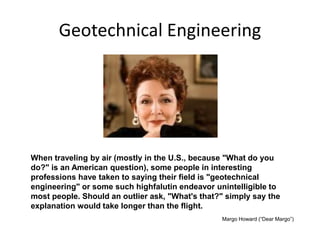A Biased View of Geotheta
Wiki Article
The smart Trick of Geotheta That Nobody is Talking About
Table of ContentsGet This Report on GeothetaEverything about GeothetaThe Greatest Guide To GeothetaThe Definitive Guide to Geotheta
They work together with civil designers, architectural designers, architects, and various other professionals to integrate geotechnical factors to consider right into the total job style and building and construction procedure. This needs efficient team effort, coordination, and interaction to ensure that the geotechnical facets straighten with the job objectives and meet governing needs.Mining & Materials Engineering: Concepts of boring, infiltration rates, and factors influencing the option of drilling approach. Features of dynamites, firing systems and blast patterns. Blowing up methods in surface and below ground functions. Special blowing up strategies at excavation boundaries. Vibration and sound control. Mechanical and constant techniques to fragmentation, consisting of longwall shearing and fullface boring.
Modelling of piece and bit dimension distributions; comminution as a transfer feature. Comminution innovation: squashing, grinding, size category. Integrated evaluation of fragmentation and comminution procedures. Provided by: Mining & Products Engineering.
Excitement About Geotheta
Bachelor's level programs in civil, geotechnical, geological, and environmental engineering usually last 4 years and consist of basic education and learning training courses in English, social scientific research, and the liberal arts, as well as programs in innovative maths, architectural geology, and liquid mineralogy. (https://geotheta.carrd.co/)Geotechnical engineering includes the evaluation of the soil and rock problems at a particular website, and their implications for the advancement of that website. As most structures depend on the ground for support, it lacks surprise that an in-depth understanding of the ground problems, and the viability of foundation systems, are important to the long-term stability and performance of the structure or framework.
Specialising in the investigation of geological developments and ground practices, geotechnical engineers execute scientific investigations and testing to understand the impact these geological developments may carry the layout and building of structure, civil and infrastructure jobs. This competence is crucial for the design and building of buildings, roads, tunnels, dams, bridges, and water and sewer systems.
The geotechnical team at Douglas Allies regularly speak with engineers, design engineers, programmers, and home builders to make suggestions on design and growth propositions to guarantee that the developed structures are appropriately developed for the ground problems. For instance, the design of footing systems needs to think about the weight of the framework, the capacity of the ground to sustain that weight together with movement resistances and effective building.
An Unbiased View of Geotheta
This task is greatly simplified by the usage of our Douglas Map geospatial platform which makes this information conveniently obtainable in a very easy to use web browser user interface. A geotechnical designer will guide the boring of boreholes and examination pits to accumulate soil and other examples, and also analyze surface functions and ground direct exposures to create a geotechnical version of the subsurface problems.Depending on the task kind and ground conditions came across, lab screening might among various other things analyze stamina, compressibility, sensitivity and/or leaks in the structure of soil and rock examples. After this data is collected and collected, the results are utilized for a geotechnical design of the website, which is typically provided as areas across the site.

A geotechnical examination by nature can only examine the ground problems at the areas drilled or dug deep into. Natural variations in dirt and rock conditions can happen across a site and between test locations. It is therefore great method that the geotechnical designer be kept throughout building and construction of the job to supply on-site verification that the ground problems run into follow the assumptions and recommendations given in the geotechnical investigation record.
The 10-Second Trick For Geotheta
Geotechnical designers use their comprehensive understanding of soil and rock to analyze risk and solve problems on varied facilities projectsGeotechnical engineering is a specialist branch of civil design which considers the practices of planet products and the application of soil and rock mechanics. Tailings Engineer. As a geotechnical engineer, you will certainly analyze the physical, mechanical and chemical properties of dirt and rock in order to develop foundations, preserving structures and earthworksGeotechnical engineering is very closely connected to and overlaps with, both engineering geology and ground engineering - https://geotheta.wordpress.com/2024/08/02/unlocking-the-secrets-of-geotechnical-engineers-the-geotheta-advantage/. It's possible to specialise in geotechnics or benefit a geotechnical business however be called an engineering rock hound or a ground designer. As a geotechnical engineer, you'll require to: construct and keep partnerships with customers have a peek at this website and other experts associated with the site, throughout each projectmaintain safety requirements on website bear in mind cost effects when you make recommendationsstudy geological maps and airborne photos from a series of sources and from various time periodsexamine construction intends to see exactly how possible they are based upon your understanding of the siteinvestigate dangers or geological dangers for the sitesearch for ecologically sensitive attributes, such as land fill start to develop valid and interpretive ground modelsplan area investigationsdrill and evaluate samples of bedrock, dirt, groundwater and extra products monitor various other experts on sitesolve technological problems as they arise, such as unanticipated structures at drill sitesmonitor problems during and after building and construction to make sure frameworks are stable in the brief and long termadding information collected on site to your first researchcreating geotechnical computations, illustrations, and two or three-dimensional computer versions translating the datamaking recommendations about the suggested use of the website

Report this wiki page